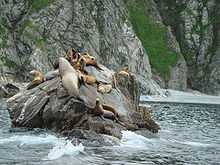Sea lion
| Sea lions Temporal range: Late Oligocene – Recent | |
|---|---|
 | |
| California sea lion (Zalophus californianus) | |
| Scientific classification | |
| Kingdom: | Animalia |
| Phylum: | Chordata |
| Subphylum: | Vertebrata |
| Class: | Mammalia |
| Order: | Carnivora |
| Suborder: | Caniformia |
| Superfamily: | Pinnipedia |
| Family: | Otariidae |
| Subfamily: | Otariinae |
| Genera | |
|
Eumetopias | |
Sea lions are sea mammals characterized by external ear flaps, long foreflippers, the ability to walk on all fours, and short, thick hair. Together with the fur seals they comprise the family Otariidae, eared seals, which contains six extant and one extinct species (the Japanese sea lion) in five genera. Their range extends from the subarctic to tropical waters of the global ocean in both the Northern and Southern Hemispheres, with the notable exception of the northern Atlantic Ocean.[1] They have an average life span of 20–30 years. A male California sea lion weighs on an average about 300 kg (660 lb) and is about 8 ft (2.4 m) long, while the female sea lion weighs 100 kg (220 lb) and is 6 ft (1.8 m) long. The largest sea lion is the Steller's sea lion which can weigh 1,000 kg (2,200 lb) and grow to a length of 10 ft (3.0 m). Sea lions consume large quantities of food at a time and are known to eat about 5–8% of their body weight (about 15–35 lb (6.8–15.9 kg)) at a single feeding.[citation needed]
Taxonomy

Together with the fur seals, they constitute the Otariidae family, collectively known as eared seals. Until recently, sea lions were grouped under a single subfamily called Otariinae, whereas fur seals were grouped in the subfamily Arcocephalinae. This division was based on the most prominent common feature shared by the fur seals and absent in the sea lions, namely the dense underfur characteristic of the latter. Recent genetic evidence, however, strongly suggests Callorhinus, the genus of the northern fur seal, is more closely related to some sea lion species than to the other fur seal genus, Arctocephalus.[2] Therefore, the fur seal/sea lion subfamily distinction has been eliminated from many taxonomies. Sea lions are related to the walrus and the seal. Nonetheless, all fur seals have certain features in common: the fur, generally smaller sizes, farther and longer foraging trips, smaller and more abundant prey items and greater sexual dimorphism. All sea lions have certain features in common, in particular their coarse, short fur, greater bulk and larger prey than fur seals. For these reasons, the distinction remains useful.
- Suborder Pinnipedia
- Family Otariidae
- Subfamily Arctocephalinae
- Genus Arctocephalus (southern fur seal; eight species)
- Genus Callorhinus (northern fur seal; one species)
- Subfamily Otariinae
- Genus Eumetopias
- Steller sea lion, E. jubatus
- Genus Neophoca
- Australian sea lion, N. cinerea
- Genus Otaria
- South American sea lion, O. flavescens
- Genus Phocarctos
- New Zealand sea lion or Hooker's sea lion, P. hookeri
- Genus Zalophus
- California sea lion, Z. californianus
- Japanese sea lion, Z. japonicus – extinct (1950s)
- Galapagos sea lion, Z. wollebaeki
- Genus Eumetopias
- Subfamily Arctocephalinae
- Family Phocidae: true seals
- Family Odobenidae: walrus
- Family Otariidae
Interactions with humans
Some species of sea lion are readily trainable and are often a popular attraction at zoos and aquariums.
The U.S. Navy's Marine Mammal Program, based in San Diego, has trained sea lions to detain scuba divers.[3]
Sea lion attacks on humans are rare. In a highly unusual attack in 2007 in Western Australia, a sea lion leapt from the water and seriously mauled a 13-year-old girl surfing behind a speedboat. The sea lion appeared to be preparing for a second attack when the girl was rescued. An Australian marine biologist opined the sea lion may have viewed the girl "like a rag doll toy" to be played with.[4][5][6] In San Francisco, where an increasingly large population of California sea lion crowds dock along San Francisco Bay, there have been incidents in recent years of swimmers being bitten on the legs by large, aggressive males, possibly as territorial acts.[7][8][9]
The Moche people of ancient Peru worshipped the sea and its animals, and often depicted sea lions in their art.[10]
Images
 |
 |
 |
 |
| A gathering of more than 40 sea lions off the coast of California | A military sea lion on board a U.S. Navy ship | A sea lion at the Memphis Zoo | A sea lion pup sleeping at Pantai Inn |
See also
| Wikinews has related news: Sea lion walks from beach into Pantai Inn in California |
| Wikispecies has information related to: Otariidae |
References
- ↑ "California Sea Lion - SeaWorld Info Book". SeaWorld. Retrieved December 26, 2013.
- ↑ Wynen, L.P. et al.; Goldsworthy, SD; Insley, SJ; Adams, M; Bickham, JW; Francis, J; Gallo, JP; Hoelzel, AR et al. (2001). "Phylogenetic relationships within the eared seals (Otariidae: Carnivora): implications for the historical biogeography of the family". Mol. Phylog. Evol. 21 (2): 270–284. doi:10.1006/mpev.2001.1012. PMID 11697921.
- ↑ Watkins, Thomas (2007-02-12). "Navy may deploy anti-terrorism dolphins". Associated Press. Retrieved 2007-02-12.
- ↑ BBC News: Sea lion attacks Australian girl
- ↑ news.com.au: Monster sea lion likely to be 'playing' with teen
- ↑ Sea lion mauls girl
- ↑ Kay, Jane (2011-06-24). "Rogue sea lion in S.F. menaces swimmers / Marauding mammal bites at least 14, chases 10 from Aquatic Park Lagoon". The San Francisco Chronicle.
- ↑
- ↑ Ashley Harrell (2009-10-07). "Too Cute to Shoot? - Page 1 - News - San Francisco". SF Weekly. Retrieved 2012-06-28.
- ↑ Berrin, Katherine & Larco Museum. The Spirit of Ancient Peru:Treasures from the Museo Arqueológico Rafael Larco Herrera. New York: Thames and Hudson, 1997.
| Wikimedia Commons has media related to Otariidae. |